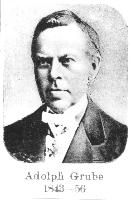Biography
After attending school in Hirschberg he studied Theology in Halle until 1795, followed by Philology. Between 1795 and 1797 he was a teacher at the Pensions-Anstalt of Wrocław. In 1798 he taught natural history at the Mary Magdalene School in Breslau before retiring in 1843.
During his time as a teacher, he published magazines and books for the general education of children and young people.
In his free time, Schilling studied the insect fauna of his homeland. He was a member of the Association of entomology in the Silesian Society (Schlesischen Gesellschaft für vaterländische Kultur) where he published a number of his scientific contributions.

Friedrich Hermann Loew was a German entomologist who specialised in the study of Diptera, an order of insects including flies, mosquitoes, gnats and midges. He described many world species and was the first specialist to work on the Diptera of the United States.

Eduard von Martens also known as Carl or Karl Eduard von Martens, was a German zoologist.
August David Krohn (1803–1891) was a Saint Petersburg born zoologist of German origin. He was the son of Abraham Krohn, the founder of Russia's first brewery, who had left the island of Rügen to serve in the court of Catherine the Great. He was the uncle of the fennoman folklorist Julius Krohn. According to legend, Krohn is said to have left for Central Europe after losing to his younger brother Leopold the competition for the hand of a Vyborg mansion owner's 15-year-old daughter. He remained unmarried until his death at the age of 88.

Hermann Friedrich Stannius was a German anatomist, physiologist and entomologist. He specialised in the insect order Diptera especially the family Dolichopodidae.

Johann Heinrich Robert Göppert was a German botanist and paleontologist.
Richard Heymons was a German zoologist and entomologist.
Johann Andreas Benignus Bergsträsser was a German educator, philologist, and entomologist.
Theodor Emil Schummel was a German entomologist who specialised in Diptera. Schummel was a private tutor in Breslau. He was a member of Schlesische Gesellschaft für vaterländische Cultur a largely scientific society which received royal ratification in 1809 after the draft of its constitution was sent to the government in Königsberg and published many of his shorter scientific papers on insects in the society's journal Übersicht der Arbeiten und Veränderungen der Schlesischen Gesellschaft für Vaterländische Kultur, abbreviated Übers Arb. Ver. Schles. Ges. Vaterl. Kult.
Maskil Moses Hirschel was a German writer, polemicist and chess author.

Empis is a genus of dance fly, in the fly family Empididae. It contains the following subgenera and species:

Adolph Eduard Grube was a German zoologist.

Eduard Fenzl was an Austrian botanist.

The Lordship of Hummel is a historic landscape zone in the western part of the former County of Kladsko, then part of Bohemia, now in Silesia, Poland.

Ernst Stizenberger was a German physician and lichenologist.

Grafenort Castle is a (former) stately residence in the Kłodzko Land of the Lower Silesia. A sixteenth-century German foundation, it has been in the hands of the von Herberstein family of Grafs or Counts since the second half of the seventeenth century until 1930 — hence its name, and one of the former names of the village in which it is situated.

Emil Ernst August Tietze was an Austrian geologist.
Schlesische Arbeiter-Zeitung was a left-wing German language newspaper published from Breslau, Province of Lower Silesia, Weimar Germany between 1919 and 1933.
Heinrich Scholz was a German entomologist who specialised in Hemiptera and Diptera.
Otto Wilhelm Hermann Reinhardt was a German botanist and conchologist. He was a teacher at a trade school in Berlin. Reinhardt was a friend of Paul Friedrich August Ascherson and co-founder of the botanical society in Brandenburg province.
Berthold Stein (1847–1899) was a Polish botanist and lichenologist. After working as a disciple at the Botanical Garden in Berlin in 1865 he became superintendent at the Innsbruck Botanical Garden. He held this position from 1873 to 1880, during which he also started to collect lichens. From 1880 to 1890 he was royal superintendent at the University of Wrocław Botanical Garden. Based on a quote in 1879 by Stein himself he can be considered as a student of G.W. Körber. His main area of interest was the flora of Silesia.
This page is based on this
Wikipedia article Text is available under the
CC BY-SA 4.0 license; additional terms may apply.
Images, videos and audio are available under their respective licenses.










